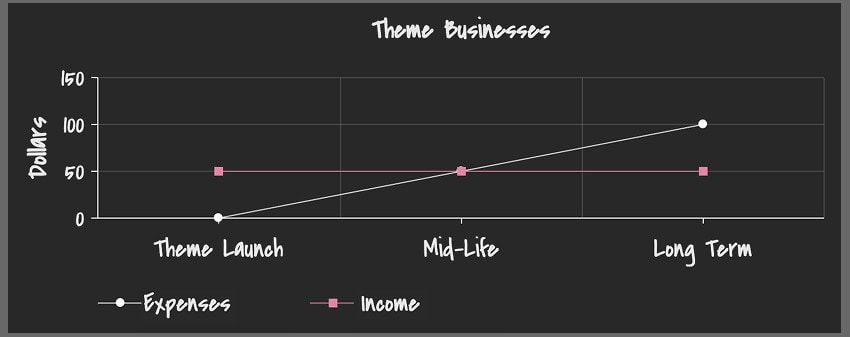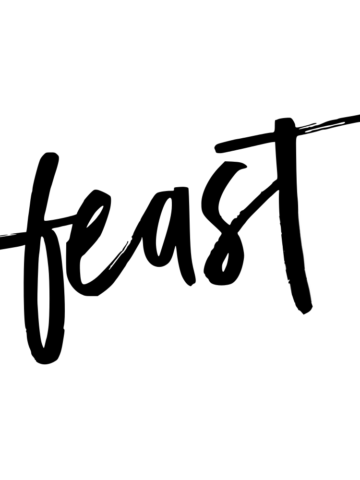Well, in the traditional sense they are.
Themes should be chosen purely for base styling, not functionality.
As of 2021, we consider the Feast Plugin setup essential for all recipe sites older than 12 months.
Note: we're not discontinuing theme "updates". We'll continue releasing styling-based updates and compatibility fixes wherever possible.
Jump to:
Block Editor
The block editor is fundamentally changing how ALL of WordPress is designed and configured. Most professional developers we've spoken to that are monitoring the development and roadmap at WordPress have come to the same conclusion: they're working on eliminating themes altogether.
There's no known timeline for this, but by our best estimates, this transition should be significantly underway in 3-4 years. That means that about 1/4 to 1/3 of sites have transitioned to the new model and the remaining sites will simply be outdated and not buying themes anyways. This will lead to the theme market drying up and companies going out of business.
A side effect of this is that how things are implemented in WordPress are fundamentally changing over the next few years. This means that all themes are going to need to be completely rebuilt and replaced. Not just themes - many plugins as well.
This was a driving reason that the Cookbook plugin was shutdown. It's why the revision manager plugin has been replaced by the revision manager TMC plugin.
It's why WordPress' own Woocommerce product isn't able to be edited in the block editor without moving to a brand new plugin.
Sidebar: The block editor and FSE (full site editor) are an ambitious project that will ultimately make editing a site more pleasant, years down the road from now. The idea is solid.
But WordPress is completely and utterly incompetent at rolling this out in a user-friendly manner. The execution is terrible for users.
Their entire feedback loop is comprised of thousands of developers who like shiny new things, and not the millions of businesses actually running the sites and funding the entire operation. Businesses and site owners value stability and predictability. The transition over the next couple years is going to be horrible for millions of websites.
After all this is said and done, the input process for building a site is going to fundamentally change, but the output (the on-page content) is going to be exactly the same as it was 10 years ago.
The FSE is scheduled for "release" in December 2020. We recommend ignoring it until December 2021 at MINIMUM.
Terrible business model
The business model of selling themes for a one-time purchase is fundamentally (excuse the french) merde.
It leads to a business where your support costs increase linearly, while sales remain constant. It doesn't take a Harvard MBA to figure this one out:

To respond to this, theme companies continually release new themes, which restarts the cycle of people having to purchase new themes.
This is like selling a car you know is going to break down in 3 years, and knowing the person will have to come back for another car in 3 years.
And the transition to a new theme is painful and tedious. So many minor technical details get overlooked, which can undo years of hard work.
Fortunately, software doesn't have to operate like the physical world. Instead of selling a product with a limited life, all major software companies have moved to a subscription based business model.
Except for theme companies, for whatever reason. I'll label this part momentum, and part lack of business experience. The majority of themes are built by competent developers and designers, who have fundamentally no idea how to build a business. It's an entirely different skillset.
To be clear: companies will continue pushing themes for a long time. New companies will release themes. It's money in the bank to them. But we now know this is a merde way to run a business.
Fundamentally flawed
Themes have a fundamental issue: they're overwritten during updates. To resolve this, "child themes" were created that were created to allow the customizations to be put into child themes, which are never updated and therefore never overwritten.
That was the theory, 10-15 years ago. It's proven to be very, very wrong.
All of our themes are child themes, of the Genesis parent-theme.
Child themes absolutely do need to be updated, and then suffer the same problems that parent themes did. Even custom $20,000+ child themes start to become outdated in just a few years and need to be redone.
Why is this a problem? Well, the theme you bought with a built-in recipe card is riddled with errors and outdated schema, and the content built into that recipe card is extremely difficult to import into a modern recipe card.
Now multiply this by every one of dozens of features built into a theme.
Theme lifecycles
Between the time a theme is spec'd out and developed and tested and finally released, 6-12 months can have passed. In just that short period, the original specs may be outdated.
Within a year after release, a few components will have definitely been rendered obsolete.
Within a year or two from that, a good chunk of the theme is now outdated and needs to be updated.
This leads to a cycle where a new (child-)theme needs to be purchased or reinstalled every couple of years.
This isn't the theme's fault or the developer's fault. Nobody has a crystal ball that can predict the changes. We don't know how things will evolve over time. We can simply make educated guesses.
Do you want to know a not-so-secret secret?
Everybody hates updating themes. So much, that at least half the people running our themes have never updated.
A better model
All the above leads to the only logical conclusion, that themes are bad for the company selling them and bad for people buying them. To date, we haven't spoken to anyone who has a solution to this.
But there are alternative models out there: plugins. Specifically, paid plugins.
Plugins are designed to be updated regularly. The version you released in 2018 can be updated in 2019 and 2020 and beyond.
Paid plugins also provides the necessary funding to pay professional developers to integrate feedback from outside experts, and test and release those updates.
This leads to a situation where your site stays up to date all the time with more frequent, minor changes.
No more nerve-rattling theme updates that require everything to be reconfigured. Or sites that are running best practices from 2016 (I'm looking at you, people on Foodie Pro 2.0).
The more regular recurring revenue through a subscription model also allows for an expanded area of responsibility:
- How you write content isn't the theme's responsibility
- How you structure your content with headings isn't a theme's responsibility
- How you structure your site isn't the theme's responsibility
- How you comply with site quality guidelines isn't a theme's responsibility
- Which settings you set for SEO (Yoast) and pagespeed (WP Rocket) isn't a theme's responsibility
These are not theme-related, yet we've been able to touch on at least the basics of all this over the last few years as we're transitioning to the Feast Plugin.
And unlike theme lifecycles that are investing tons of time up front in speculating what the future holds, plugins can release version 1, and iterate and improve on it as the environment evolves.
This is why we've transitioned to a release early, release often software model for the Feast Plugin.
So how do you pick a theme?
Simple: pick a theme based on which base-styling you like best. Functionality does not belong in themes. Get the Feast Plugin for up-to-date functionality.
You can then tweak and modify the theme as needed via customizations to make it your own.
But a theme is a very, very small component of a very broad and complex ecosystem that helps you run a site. Don't over-rely on themes for anything aside from styling.
Why Feast?
Since 2014, we've grown to...
- 6,293+ active installations *
- 68+ countries worldwide *
- 26+ languages *
- 5,691+ support tickets
- 1,457+ Github commits (updates)
This means that we have the largest user base in the food blogging industry, a massively diverse range of customers, the broadest set of publicly-available tutorials, and the most consistent set of up-to-date best practices that bloggers care about.
* these are numbers we were able to verify, lifetime installs between all themes are over 10,000, many of which have been customized or had branding removed


Mohit says
I'm running Foodie Pro Theme 3.1.7 with customizations. If I now implement the feast plugin; can I do away with updating the theme to the most recent version? How can I maintain customizations if I need to update the theme.
Skylar says
We generally only support themes that have been updated within the past year, you can find the changelog: https://feastdesignco.com/product/foodie-pro/#changelog
As of April 13, 2020 this will be version 4.0.8. That means version 3.1.7 is unsupported.
The plugin lives alongside the theme and does not replace it. Our goal over time will be to replace theme functionality so that theme updates will be less frequent and less necessary, but it will never entirely replace theme updates. Theme updates will always be necessary to some extent, they'll just be much easier to manage.
For more details see https://feastdesignco.com/feast-plugin/
To answer your question: no - the plugin doesn't mean you don't need to update your theme. It just means that theme updates will be easier in the future. Here's our guide to different customizations: https://feastdesignco.com/types-of-customizations/